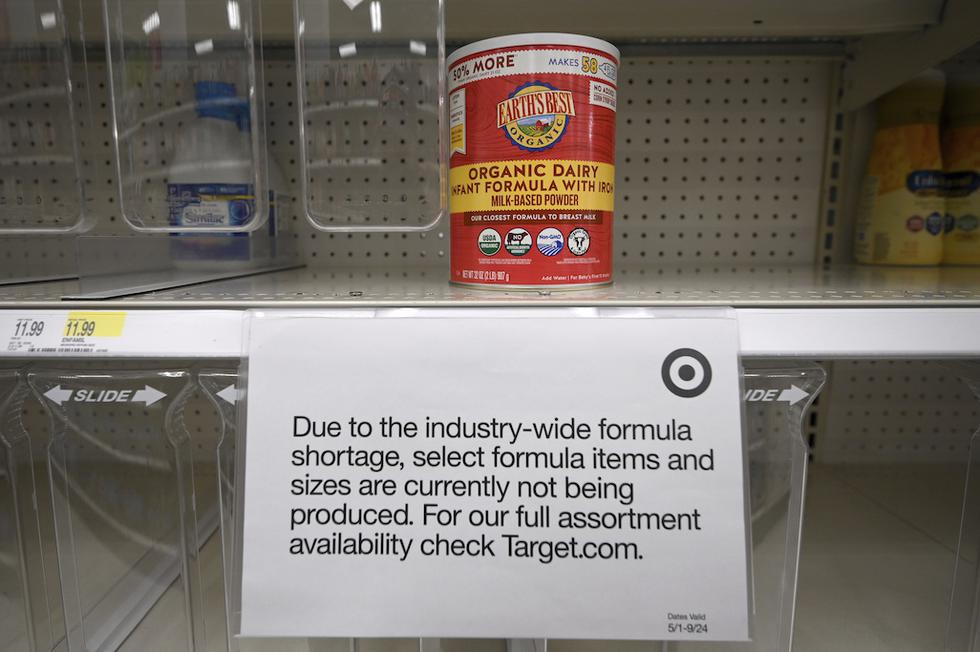https://prospect.org/blogs-and-newsl...mula-shortage/
Monopolies and the Baby Formula Shortage
Today on TAP: Four companies sell almost all baby formula in the U.S., magnifying supply shocks that cause families to scramble.
by
David Dayen
May 10, 2022

Anthony Behar/Sipa USA via AP Images
A sign indicates low stock of baby formula at a Target store in the Queens borough of New York City, May 10, 2022.
Families are desperately hunting around drugstores and groceries for baby formula amid a
nationwide shortage. Analyst
Datasembly indicates that 40 percent of leading baby formula products were out of stock in late April. Yes, that
refers to all sizes of the same product (it’s 40 percent of the SKU numbers, not 40 percent of all formula), but the problem shouldn’t really be minimized: Businesses are rationing and parents are scrambling, even if switching brands doesn’t typically carry any health consequences (though that
isn’t always the case).
Why is this happening, exactly? Well, there was a
large recall of Similac, one of the major brands, in February. But I am having a hard time with the alibi of another large brand, Enfamil, which
has claimed an “18 percent surge in demand for baby formula nationwide.”
Was there a large influx of babies that I’m not aware of? Have they all gotten hungrier? Contrary to myth, the pandemic and the forced lockdowns did not lead to a baby boom; in fact, they led to a
baby bust. U.S. births
declined in the first half of 2021, the last point for which we have data. Even if there was an uptick later, it’s extremely unlikely to see an 18 percent surge.
Left unsaid by formula manufacturers is their iron grip on the market, which exacerbates supply disruptions. The shortage is a manifestation of the same
problems we’ve seen with the supply chain, made worse by monopoly.
As of 2018, four companies—Abbott (which makes Similac), Reckitt Benckiser (Enfamil), Nestlé (Gerber), and Perrigo (which makes store-brand formula)—control about 89 percent of the U.S. market. Any disruption to one of their products will be magnified, whether it’s a recall for Similac or inability to source ingredients. A few companies in the market relying on the same sources creates a much more fragile supply chain.
Keep in mind that baby formula consists mostly of dehydrated cow’s milk, vitamins, and a ton of sugar. Yet it somehow costs at least $150 and
as much as $428 a month, high enough to
sustain a mass crime ring even before the price jumped 18 percent over the past year. This is probably not as distressing to the oligopolistic companies selling the stuff as it is for families.
Some have suggested that the Women, Infants and Children (WIC) program is responsible for the shortages. Half of all U.S. formula consumption goes through WIC, which
provides free infant formula through a competitive bidding process where states negotiate bulk discounts in exchange for market exclusivity. But that program has been in place since the 1980s; it cannot be responsible for the inflation over the past year. Similarly, research has found
little or no effect between the WIC program and higher retail prices for non-WIC families.
The competitive bidding setup does tend to concentrate the market, however. (It’s a bit of a chicken-or-egg problem; market concentration may have caused few WIC bidders, not the other way around.) This is manageable except in cases of supply shock, as we’re now seeing. The antitrust agencies should definitely take a look.
Meanwhile, one shouldn’t deny the fierce use of lobbying to cement the industry’s monopoly. During the Trump administration, U.S. delegates to the United Nations
threatened countries with trade sanctions and withdrawal of military aid if they supported an anodyne international resolution in support of breastfeeding as a healthy option for infants. That was stage-managed by the baby formula industry, which particularly wanted to keep its lock on the developing world. The interests of private monopolists were put ahead of public health and security.
The dominant companies claim to be ramping up production to solve the shortage. It should be noted that their incentives run in the other direction, to keep prices high by putting a lid on supply. When you’re a monopolist, you can do that without much trouble.
